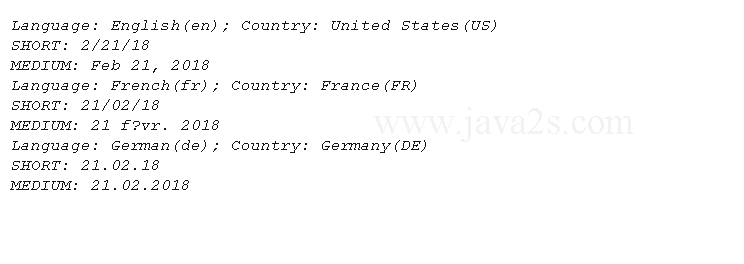Java - Legacy Date Time Formatting
Introduction
Java library provides two classes to format legacy dates:
java.text.DateFormat java.text.SimpleDateFormat
Use the DateFormat class to format dates using a predefined format.
It is an abstract class. You can call one of its getXxxInstance() methods, where Xxx can be Date, DateTime, or Time, to get the formatter object, or just getInstance().
The formatted text depends on two things: style and locale.
Use the format() method of the DateFormat class to format a date and time.
The style of formatting determines how much datetime information is included in the formatted text.
Locale determines how all pieces of information are assembled.
Style
The DateFormat class defines five styles as constants:
- DateFormat.DEFAULT
- DateFormat.SHORT
- DateFormat.MEDIUM
- DateFormat.LONG
- DateFormat.FULL
DEFAULT format is the same as MEDIUM, unless you use getInstance() where the default is SHORT.
The following table shows the same date formatted in different styles for a US locale.
| Style | Formatted Date |
|---|---|
| DEFAULT | Mar 27, 2018 |
| SHORT | 3/27/03 |
| MEDIUM | Mar 27, 2018 |
| LONG | March 27, 2018 |
| FULL | Thursday, March 27, 2018 |
Demo
import java.text.DateFormat; import java.util.Date; import java.util.Locale; public class Main { public static void main(String[] args) { // Get the current date Date today = new Date(); // Print date in the default locale format Locale defaultLocale = Locale.getDefault(); printLocaleDetails(defaultLocale);/*from w ww . jav a 2s . c om*/ printDate(defaultLocale, today); // Print date in French format printLocaleDetails(Locale.FRANCE); printDate(Locale.FRANCE, today); // Print date in German format. // We could also use Locale.GERMANY // instead of new Locale ("de", "DE"). Locale germanLocale = new Locale("de", "DE"); printLocaleDetails(germanLocale); printDate(germanLocale, today); } public static void printLocaleDetails(Locale locale) { String languageCode = locale.getLanguage(); String languageName = locale.getDisplayLanguage(); String countryCode = locale.getCountry(); String countryName = locale.getDisplayCountry(); // Print the locale info System.out.println("Language: " + languageName + "(" + languageCode + "); " + "Country: " + countryName + "(" + countryCode + ")"); } public static void printDate(Locale locale, Date date) { DateFormat formatter; String formattedDate; // Format and print the date in SHORT style formatter = DateFormat.getDateInstance(DateFormat.SHORT, locale); formattedDate = formatter.format(date); System.out.println("SHORT: " + formattedDate); // Format and print the date in MEDIUM style formatter = DateFormat.getDateInstance(DateFormat.MEDIUM, locale); formattedDate = formatter.format(date); System.out.println("MEDIUM: " + formattedDate); // Print a blank line at the end System.out.println(); } }
Result

Locale
java.util.Locale class contains constants for some common locales.
You can use Locale.FRANCE for a locale with language "fr" and country code "FR".
Locale frenchLocale = new Locale("fr", "FR") ;
To create a Locale, use a two-letter lowercase language code and a two-letter uppercase country code if the Locale class does not declare a constant for that country.
Language codes and country codes have been listed in ISO-639 code and ISO-3166 code.
Some more examples of creating locales are as follows:
Locale hindiIndiaLocale = new Locale("hi", "IN"); Locale bengaliIndiaLocale = new Locale("bn", "IN"); Locale thaiThailandLocale = new Locale("th", "TH"); You can use the Locale.getDefault() method to get the default Locale for your system.
Exercise
- Write code to convert Date value in long to String
- Write code to format Date To String in yyyy-MM-dd format
- Write code to parse String in yyyy-MM-dd format To Date
- Write code to convert date String to some time ago Format
- Write code to get Current Date in yyyy-MM-dd hh:mm:ss format
- Write code to get Date By Time Stamp long value in yyyy-MM-dd hh:mm:ss format
- Write code to convert Time in yyyy-MM-dd HH:mm:ss format to time in millisecond in long value
- Write code to format Date as dd/MM/yyyy
- Write code to format Timestamp in long value to string in yyyy-MM-dd HH:mm:ss format